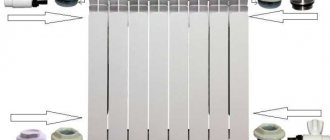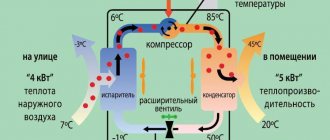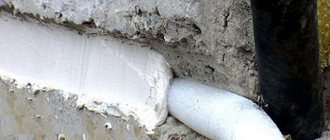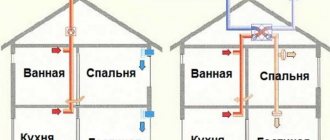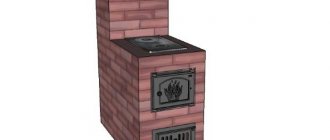Advantages and disadvantages of a water heating system
The main disadvantage of water heating in a private home is the need to purchase a large number of different materials. Namely: pipes, shut-off valves, fittings, radiators, boiler and circulation pump. The latter is not used in all systems.
And other shortcomings that can be described as nonsense if the owner of the house is indifferent to his home:
- Water leaks during operation. Today this situation is rare because plastic pipes have been replaced by plastic pipes. But even they sometimes leak at the junctions with other materials. These are already claims against the installation manufacturer.
- The water inside the system may freeze if it is not drained for the winter. This situation is for houses that are not used during the cold season.
Plastic pipes have solved many problems
Water heating has more advantages, which is why the majority of developers of new houses choose it:
- uniform distribution of heat throughout all rooms;
- installing one heating boiler makes it possible to control the process from one place;
- all equipment, except radiators, and piping can be made hidden. That is, organize a boiler room in the office space, and hide the pipes in grooves on the walls or in the floor. Using a heated floor system generally solves the problem of hidden installation. Even the radiators will not be visible;
- The coolant temperature does not exceed +95°C. And the surface of the batteries heats up to +65°C. You can’t get burned on them; dust doesn’t burn on them;
- water heating produces soft heat.
Heating system with hidden pipe wiring
Autonomous heating system with air convectors
An autonomous air heating system usually involves the use of electric convectors, the built-in fan of which supplies air to the heating elements, after which it enters the room. Air conditioners operating in heating mode, and ordinary cheap electric heaters without fans with an open spiral, or oil heaters, where the heating element is immersed in the coolant, can heat the air. The latest technology is the use of energy-saving air-to-air heat pumps for heating; the thermal energy obtained as a result of their operation is transferred to the air masses and distributed throughout the entire area of the room due to built-in fans.
Heating rooms with heated air is not a very popular method among consumers and has the following features:
- All air heating options allow you to heat a room in a short time, unlike water heating, which requires significant time intervals to start supplying heat.
- Electric convectors with an open spiral burn oxygen - this worsens indoor air quality and can cause headaches.
- If one convector is used to heat several rooms, you will have to install a bulky air duct system and suspend it from the ceiling.
Rice. 5 Heating with air conditioners
- In addition to heating, a high-tech heat generator (air conditioner) is capable of performing the functions of humidifying, filtering or cooling air during the warm season.
- The heating installation and ventilation ducts are not at risk of defrosting during the cold season, as well as leakage of the coolant in the system, which is air.
- Air heating is easy to implement in any room of large or small area; in the simplest case, it is enough to connect the convector to an outlet to receive heat.
In addition to small heat generators running on electricity, stationary large heat generators running on gas or liquid fuel are used for air heating; their main components are (Fig. 7):
- Gas burner placed in a large volume container (housing).
- Combustion chamber in which gas combustion occurs and its thermal energy is transferred to the air.
- A system of fans providing air exchange and supply of heated air into the air ducts.
- Air duct hoses that direct the flow to different rooms.
- Electronic automatic control and monitoring system with setting the operating mode and temperature parameters of the convector.
Rice. 6 Autonomous heating system with heat pumps
Features of a water heating system
From the name itself it becomes clear that the coolant in this case is water. This is the environment that accumulates thermal energy well and releases it easily. It has a high heat capacity, expands when heated, but contracts poorly when pressure increases. Water density is 950 kg/m³. The principle of operation of water heating is quite simple. The water is heated in the boiler, and then moves through pipes to the radiators, where it gives off its heat, and returns through the return circuit to the boiler.
How the coolant moves through the heating system
The main task of the heating assembly is to force the coolant to move along the circuit. Therefore, there are two types of heating systems: with natural circulation of coolant and with forced circulation. In the first case, water moves through the pipes under the influence of physical laws, when the warm medium rises up and the cold medium goes down. In the second, movement occurs due to the operation of the circulation pump. But more on that below, and now let’s look at what materials and equipment are best to choose for installing water heating.
Autonomous heating system - operating principle and main components
Any autonomous heating system includes the following main components:
Heat generator. It is a device that converts electrical or energy from burning fuel into heat, while the heat generator simultaneously transfers thermal energy to the coolant. Two main forms of the environment are used as a thermal carrier - air masses and liquid. Most often, purified distilled water is used in heating systems, which has the highest heat capacity coefficient, that is, the ability to transfer and accumulate energy; all other liquids, including non-freezing antifreeze, are significantly inferior to water in this indicator.
To convert fuel into thermal energy and transfer it to the carrier, the process of combustion occurs in heating boilers; if electricity is used, the heating of the coolant medium is carried out by heating the material with high electrical resistance to alternating current and its mutual heat exchange with the working fluid.
Heat conduction line. The coolant heated in the boiler is supplied to the heat exchange devices through pipes. Previously, steel pipelines were widely used (less often copper due to high cost), with the development of the chemical industry, steel is gradually being replaced by pipes made of polymers: PPR polypropylene, cross-linked polyethylene and PEX metal plastic.
Polymer pipes, due to their flexibility and elasticity, made it possible to install multi-circuit heated floors with water heating in buildings, which was impossible to do with metal pipelines.
Heat exchange devices. The coolant from the boiler flows through pipes into heat exchange devices, which in most cases are radiators; the liquid passes through them and transfers heat to the air due to the large area of the heat exchanger body. To increase or decrease thermal output, it is possible to change the battery configuration by adding or removing individual sections; the radiators are made of steel or aluminum, which have good heat output (high thermal conductivity).
Rice. 4 Air convector - operating principle
Basic elements of water heating
The water heating system includes:
- heat generator, also known as a boiler or furnace;
- pipes;
- radiators;
- circulation pump;
- expansion tank.
Complete set: boiler, radiators, pump and expansion tank
Heating boilers
Before purchasing and installing a heating boiler in a private home, you need to calculate its power. This indicator reflects the amount of thermal energy supplied. And the larger the area of a private house, the more powerful the equipment must be installed.
Gas generator for heating a private house
It is easy to calculate the power of the unit. To do this, you need to know one ratio - for 10 m² you need 1 kW of thermal energy. This takes into account that the height of the ceilings in the rooms is no more than 3 m. But it is necessary to understand that this ratio will act differently in different climatic regions. Therefore, SNiPs contain climate coefficients.
| Region | Northern | Middle lane | Southern |
| Coefficient | 1,5-2,0 | 1,0-1,2 | 0,7-0,9 |
For example, the total area of a private house located in Murmansk is 100 m². The boiler power is determined as follows:
- 100 / 10 = 10 kW;
- 10 x 2 = 20 kW , where “2” is the northern coefficient.
Liquid fuel boiler assembly
Now, regarding the classification. Heating units are mainly divided according to the type of fuel used: gas, electric, solid or liquid fuel. If gas is installed in the house, then this is the best option. All other types are considered taking into account what is beneficial. If the power supply is inconsistent or the network voltage is weak, then it is better to give preference to solid fuel boilers. By the way, the latter are not only wood-burning structures, they are modern pellet options, which have wider functionality and higher efficiency.
Solid fuel wood boiler in operation
Attention! Purchasing a boiler is not cheap, so fireplaces and kitchen stoves in which a heat exchanger is installed can be used as heating generators.
Electric heating boiler
Related article:
Long-burning wood-fired boilers for the home. From this publication you will learn everything about wood-burning boilers, their types and nuances of use.
Pipes
Everything is simple here - you only need to use the plastic version. Pay attention to its temperature limit for use. Because there are pipes for cold water and for hot water. In heating, the second position is used.
Plastic pipes for heating
You can talk about the diameter of the pipes only after a full calculation of the system. But first we can say that material with a diameter of less than 40 mm cannot be used for the supply and return circuits. Radiator connections are products with a diameter of 20-25 mm.
Related article:
Heating pipes: which ones are better. Varieties of products, their advantages and disadvantages, how to choose the right diameter, how to insulate - you will find all this and much more in our publication.
Radiators for heating
Manufacturers today offer four types of heating batteries:
- cast iron,
- steel (tubular or panel),
- aluminum,
- bimetallic (steel pipes inside, aluminum on top).
Cast iron radiator - accordion
Related article:
What heating radiators are best to install in an apartment. In this review we will look at the types of radiators, their advantages and disadvantages, popular models and manufacturers.
Each type has its own pros and cons. For example, cast iron heats up slowly, but retains heat for a long time. Aluminum heats up quickly, gives off the most thermal energy, but quickly corrodes. In this regard, the best option is bimetallic or steel, as the golden mean.
Steel tubular radiator
It is important to calculate the required number of battery sections, because this value determines how much heat will be released into the rooms of the house. It is not difficult to do the calculation yourself. To do this, you need to know the area of the room, the average heat transfer value of one section, and also take into account the ratio of the area of the room and the heat transfer from the radiator. The latter is the range of 60-200 W depending on the climate region.
Aluminum model with the highest heat output
For example, the area of a room is 20 m², the average heat transfer value of one section is 170 W, the ratio is taken to be 100 W. The last two indicators can be found in SNiPs. Now we carry out the following mathematical operations.
- 20 x 100 = 2000 W of heat will be required to heat the room;
- 2000 / 170 = 11.76 pieces or 12.
That is, it turns out that in order to heat a room of 20 m², you will need a radiator battery with 12 sections. Of course, this is an approximate calculation, because the ceiling height and battery type were not taken into account.
Bimetallic batteries with high heat dissipation efficiency and long service life
| Cast iron | Steel | ||
| pros | Minuses | pros | Minuses |
| High heat capacity | High specific gravity | High strength | They are afraid of water hammer |
| Long service life | Exclusive models are very expensive | High heat dissipation | In the absence of water, corrosion processes begin to occur |
| Withstands pressure up to 22 bar | Unpresentable appearance of accordions | Two types: tubular and panel | |
| Low price | Low impact strength | Low price | |
| Requires a small volume of coolant | |||
| Aluminum | Bimetallic | ||
| pros | Minuses | pros | Minuses |
| Highest heat output | They are afraid of water hammer | Withstand high pressure | Not the highest heat transfer compared to other models |
| Low specific gravity | Subject to corrosion | Easily cope with water hammer | Not the lowest price |
| Short service life | Very easy installation | ||
| High resistance to corrosion processes | |||
Especially for our readers, we have developed a convenient calculator for calculating the number of radiator sections.
Calculator for calculating the number of heating radiator sections
Expansion tank
Before heating a private house, you need to think through all the positions so that the end result does not disappoint. Therefore, choosing the type and volume of the expansion tank is the most important component of the installation process. Its only purpose is to absorb water, the volume of which has increased due to heating. An additional function is to remove air from the system.
Expansion tanks for heating are always red
The expansion tank can be open or closed. The first is a regular container with an open top end. That is, water comes into direct contact with air. It is usually installed above all other heating units. Warm water gradually evaporates through the open neck, so it will need to be added periodically. The second is a sealed vessel, inside of which there is a rubber membrane. Stretched by water, it creates pressure inside the system, which helps the movement of the coolant. Typically, a closed model is installed with a circulation pump. There is no mandatory requirement to install high. That is, the tank is installed in any convenient place.
As for its volume, this figure is 15% of the coolant volume. The latter is not easy to calculate. You will have to find out the volume of water that is placed in the boiler (in the passport data), in the radiators (ibid.), in the pipes. The latter will need to be calculated using the formula for the volume of cylindrical figures, taking into account the length and diameters of the pipes. It is much easier to use a calculator specially developed by our team, which takes into account all the complexities of the calculation.
Calculator for calculating the volume of an expansion tank for a heating system
Circulating water pump for heating a private house
This device is used only in systems with forced circulation of coolant. It is convenient because pressure is created inside the pipework, which increases the speed of water movement. In this way, the coolant is evenly distributed over the radiators.
Circulation pump for moving coolant
The main parameter of a water pump for heating a private house is performance. To calculate it, the formula is used: Q = N/1.16x(tout-tin), where N is the power of the generator, tout and tin are the coolant temperatures at the outlet and inlet of the boiler, “1.16” is the heat capacity of water. Temperature difference is a parameter that needs to be measured. But it is impossible to do this if the heating system is not yet turned on. Therefore, there are average indicators.
| Heating type | Radiator | With installation of convectors | Warm floor system |
| Temperature difference, C | 20 | 15 | 5 |
How to install the pump correctly
Circulation pump performance calculator
Circulation pump pressure calculator
Traditional heating system with liquid coolant
When we hear the phrase “heating system”, the first thing that comes to mind is a traditional design. In countries with cold climates, it is the main one, and the rest are auxiliary. However, in regions where the climate is milder, two other types of heating systems occupy a wide range. The traditional heating system is based on free or forced circulation of heated liquid inside a system of pipes and radiators. The latter have a ribbed structure that increases heat transfer. By and large, it includes 6 pipes, heating devices, shut-off valves and a power plant, which serves as a heat source for heating the liquid.
Schematic diagram of the simplest liquid heating system
In any traditional autonomous heating system, the boiler serves as the power plant. It can work by burning various types of fuel or use electricity to heat the coolant. Ordinary water is most often used as a coolant, but it can also be antifreeze, antifreeze, or transformer oil. The latter allow the heating system to be used in situations where there is a risk of freezing due to the boiler being turned off. The boiler heats up the coolant, which naturally begins to circulate through the system. More often, a centrifugal pump is used to circulate it, which makes it possible to achieve greater efficiency from the heating system.
The main elements of a more complex collector autonomous heating system
Principles of a traditional heating system
If you are planning to build a new house, then the nuances of the heating system need to be thought through at the design stage. This will save you from having to cut through walls and partitions. After all, it is easier to build heating even before the construction of internal partitions. In addition, if you plan to install a floor-standing boiler, you will need a separate room for it. You can, of course, do this in the bathroom or kitchen, but then it will be to the detriment of aesthetics.
In this regard, it is better to use double-circuit boilers, which are hung directly on the wall, and the chimney is discharged through it. Such boilers not only provide the house with heat, but also with hot water. They have a more aesthetic appearance and are silent, which allows them to be placed even in the kitchen. In addition, these units are equipped with a built-in circulation pump and expansion tank. The only downsides worth noting are their higher cost and complex electronics, which can fail when the power is turned off. These boilers require constant monitoring, so it is impossible to leave the house unattended for several days in winter.
Connection diagram for a double-circuit boiler
I install double-circuit boilers in houses with an area of no more than 250 m2, since their power does not exceed 30 kW. If the area is much larger, then you will need to install a powerful single-circuit boiler. In this case, to organize hot water supply, additional water heating equipment will be required: capacitive boilers or plate heat exchangers.
How to choose the right boiler for a traditional heating system
When choosing a boiler, first of all you should pay attention to the area that it must heat. In addition, the power of the unit is influenced by: the tightness of the windows, the level of thermal protection, and climatic conditions in the area. Not least important is the availability and cost of energy resources. It is most profitable to use natural gas, but if gas networks are not available, then it is worth considering purchasing solid fuel or liquid heating boilers. Electric boilers should be considered last because of the prohibitive cost of electricity. True, they have their own advantage - the absence of combustion products.
Alternative types of gas boilers
The most popular are boilers powered by the combustion of natural gas. Installation of autonomous heating using such units is most convenient. In addition, such a heating system does not require fuel reserves or storage space, because gas is simply supplied to the house through pipes from the gas distribution network. The most important element of a gas boiler is its burner, which can be atmospheric or fan. With an atmospheric burner, gas combustion occurs naturally, which at low pressure in the system can lead to premature burnout of its body. The fan system creates an artificial air flow, which forces the gas to exit the nozzle with force, protecting the burner from damage. This system is more expensive and noisier, but more efficient.
Standard burner for gas boiler
It is worth noting that for the normal functioning of a gas boiler, it is necessary to ensure high-quality removal of gases and condensate from the combustion chamber. In the case of a double-circuit boiler, it has a fan that removes combustion products into a short pipe that extends horizontally directly beyond the wall. A floor-standing boiler will require the construction of a bulky chimney of a special design.
Chimney diagram for a floor-standing boiler
Pros and cons of a traditional heating system and principles of its installation
The advantages of a traditional heating system include its energy efficiency. Only it is capable of heating sufficiently large areas in cold climates at minimal cost without the use of complex structures. The disadvantages include a certain complexity of installation and the high cost of the entire set of equipment. The need for a large amount of non-renewable fuel can also be considered a disadvantage from an environmental point of view.
Today, polypropylene pipes and bimetallic radiators are most often used for installing a liquid heating system. This allows you to independently assemble a heating system according to the diagram using a special soldering iron in a fairly short time. The pipe laying scheme can be of several types. You can read more about this in thematic articles.
In general terms, it can be noted that batteries are usually installed under windows, connecting them to the pipe using shut-off valves. This will allow you to remove the radiator if necessary without draining and stopping the entire system. To calculate the number of radiators depending on the area of the room, there are special tables and formulas.
Table for calculating the need for heating radiators
When using a floor-standing boiler, an open heating system is constructed. That is, at its upper point there is an open expansion tank, where you need to add water from time to time. It is needed to compensate for the thermal expansion of water when heated. A wall-mounted double-circuit boiler is already equipped with an expansion tank, which is closed, and water is added to such a system directly from the water supply under pressure. That is, before purchasing such a boiler, you must install a water supply system in your home, the pressure in which can ensure that the heating system is filled with water.
Classification of water heating systems
As mentioned above, heating is divided according to the method of movement of the coolant into: natural circulation and forced.
Heating system with natural coolant circulation in a one-story house
Let’s immediately make a reservation that a heating system with natural circulation is best used in one-story houses. The thing is that the coolant cannot rise high even at a temperature of +95°C. Of course, no one limits the height of the distribution; it’s just that the system itself will work ineffectively.
Schematic diagram of heating with natural circulation of hot water
The essence of natural circulation is the movement of water under the influence of the laws of physics. But there is one nuance here that you need to know when installing heating yourself. This is the slope of the horizontal contours from the boiler towards the radiators and from the radiators to the boiler. This figure should be at least 0.5%. That is, this is enough to force the water to move by gravity.
Attention! The advantage of this scheme is complete independence from electricity.
What you need to pay attention to when installing heating without a pump:
- The boiler must be located in the lowest place relative to all pipework. The optimal height difference is 0.5÷1 m.
- The expansion tank is installed above the entire pipework. The height difference is up to 0.5 m.
- The riser leaving the boiler must be directed vertically upward.
- The speed of coolant movement in the system must be no less than 0.1 and no higher than 0.25 m/s. To achieve this, it is necessary to accurately calculate the diameter of the pipes used, taking into account the temperature of the water at the outlet and inlet.
- If heating of this type is equipped with a closed expansion tank, then it is installed at the level of the boiler. In this case, it is necessary to install an air vent into the system, which must be installed at the highest point of the pipe distribution.
Scheme with forced water circulation
Heating diagram for a one-story house with forced circulation of coolant
This scheme differs from the previous one not only in the presence of a pump, but also in the location of the pipes. There is no need for installation at an angle. This is very important for those who are assembling a heating circuit for the first time.
But there is one very important nuance in this system.
Attention! The pump must be installed on the return circuit near the boiler. It is in this area that the coolant temperature is lowest. And this is important for the pump, or more precisely, for its rubber gaskets and cuffs, which simply cannot withstand high temperatures. They will begin to shrink and burst, which will lead to leaks and failure of the pumping unit.
Correct pump installation location
It should be noted that the heating scheme with forced circulation can be used not only for one-story houses. If you accurately calculate the power of the circulation pump, it will easily pull several floors. Although experienced plumbers recommend installing several boilers with separate pumps for a large house with several floors.
Related article:
Heating a country house: options and prices. A separate review provides a comparative analysis of various heating methods with tips and recommendations.
Choosing a boiler for a heating system
The most important criterion when choosing a boiler is undoubtedly the size of the total area of the house. The power of the boiler can be significantly affected by such factors as: the tightness of windows and doors, weather conditions, and the level of thermal protection. When choosing a boiler, you also need to take into account how much independent heating costs - that is, energy resources, and how accessible they are. If possible, the heating system must be connected to a gas source. If the gas network is not available, then the boiler must be selected that will operate on solid or liquid fuel.
Electric boilers, although not widely popular, have the advantage that no combustion products are emitted during their operation. Boilers operating on solid fuel are also not very popular. This can be explained by the fact that the owners of private houses are afraid of their operating conditions and the fact that solid fuel needs to be stored somewhere. It also happens that it is possible to install only a boiler that runs on solid fuel. There are some recommendations that will help minimize the disadvantages of this type of heating system.
|
|
By installing additional equipment, you can reduce the number of fireboxes by half. Another way would be to use heat accumulators, which can provide good heating conditions for the entire heating season.
Gas boilers are the most popular.
Using such boilers, you can most successfully organize the installation of independent heating. Such boilers can be single-circuit or double-circuit. If the autonomous heating installation plans to use a boiler that runs on liquid fuel, then you must first find a place to store it. It is best to place the fuel tank as close to the boiler room as possible so that the distance is not too great. The boiler room can be buried in the ground or installed on top of it. The main component of a gas or diesel boiler is the burner. Such an element can be atmospheric or fan.
Boiler burner
An atmospheric burner is usually included in the basic package of the boiler. Its main disadvantage is that if there is low pressure, the fire can move to the burner, and this will lead to its rapid combustion. A fan burner consists of a fan that creates a flow of air, and this entails drawing gas out of the nozzle. The main disadvantages of such a burner are the high cost and the noise that is produced during operation of the boiler.
Radiator connection diagrams
For ordinary people who do not think about how radiators are connected in their own home, it does not matter what circuit is used. The main thing for them is warmth in the house. But, as practice shows, it is the connection diagram of radiator batteries that affects the quality of heat transfer. And there are two schemes: one- and two-pipe.
How to make a one-pipe heating system for a private house with your own hands
First of all, you need to understand why it is called that. In essence, a single-pipe is a ring with a boiler in the center. The pipes are laid close to the floor in a circle, with batteries connected to them. Each of them takes the coolant from one side from the lower pipe and squeezes out already cooled water into the same pipe from the other opposite pipe (lower).
Let's face it, it's not the best option, because it has one significant drawback. The radiators far from the boiler receive coolant with a significantly reduced temperature. That is, the batteries closest to the boiler will be hot, the ones farther away will be warm. This means that some rooms will be cool.
Single-pipe with connection of radiators to one circuit
But if a private house is small with 3–6 rooms, then a single-pipe heating system in it is justified due to the ease of installation with your own hands, plus a small number of pipes, shut-off valves and fittings. That is, this is the most economical option in terms of construction. Although the scheme and procedure for installing single-pipe heating are considered simple, the responsibility of the operations carried out is still high. This is especially true for systems with natural coolant circulation. Here it is important to accurately observe the slope of the pipework.
Two-pipe scheme
This water system is more complex for installation work, plus it uses more materials. But it works much better than a single-pipe one. Purely structurally, the layout of the pipes in it consists of two circuits: supply and return. It should be noted that both pipelines are blind and are connected to each other only through radiators and a heating boiler. From the names themselves, it becomes clear that heated coolant is supplied to the radiators through the supply circuit, and cooled coolant is discharged to the boiler through the return circuit.
In this case, radiators can be connected to the supply circuit in different ways. Option one is a circuit with lower wiring. This is when the coolant supply pipe runs along the floor with a connection to the upper radiator pipes. The return is carried out right there, but with a connection to the lower pipes of the heating batteries.
Two-pipe with bottom wiring
The second option is a top-wiring scheme. This is when a pipe riser is drawn upward from the boiler, which goes into a circuit that distributes the coolant to the radiators. The latter is mounted under the ceiling or in the attic. The return line is installed, as usual, at floor level or in the basement.
Attention! All pipes in unheated rooms (attic) are thermally insulated.
It is necessary to indicate that the upper distribution is two options for distributing pipes from the riser.
- When one horizontal pipe is laid, and risers of small diameter pipes are lowered from it to the radiators from above.
- When a collector is installed on the riser, from which each battery has its own circuit. Such a system is called a collector system. Although people often hear other names - spider or ray circuit. By the way, experts believe that this is the best option for a private home if the task is to install heating yourself. It is the most effective, but also the most expensive in terms of pipe consumption.
Two-pipe with top wiring
Pay attention to the photo above. It clearly shows sections of the heating system, where “1” is the general circuit, “2” is the main riser from the boiler, “3” is a horizontal section with a slope, usually located in the attic. “4” are risers that supply coolant to the radiators. “5” are risers that remove coolant from the batteries and “6” is the return line.
And there are two more types of two-pipe systems - with horizontal wiring and vertical. The first is used for one- or two-story buildings, the second for multi-story ones. A distinctive feature of the second before the first is the presence of a high riser, from which supply circuits are distributed among the floors.
Operating principle of an autonomous heating system
The heart of any autonomous heating system is the heating boiler. The main difference according to which boilers are classified into separate groups is the type of fuel used.
Domestic gas heating boilers
The operating principle of boilers of different groups remains unchanged, regardless of the model of equipment and the characteristics of the fuel used.
When burning loaded fuel, the boiler heats water or other coolant used in a specific autonomous heating system. The pipes give off heat to the batteries and the surrounding space.
Schematic diagram of a pyrolysis boiler
The main operational and technical properties of the heating boiler depend on the type of fuel used. They have a direct impact on the durability, reliability and performance of the device. These same properties determine the ease of control of the heating system and the ease of its operation.
The complexity of installing an individual heating system also largely depends on the characteristics of the boiler. You need to study the features of existing equipment and choose the system that best suits your specific case.
Combined heating boilers
DIY heating schemes in a two-story private house
Two-story private houses are the most frequently erected buildings today. Therefore, a large number of people are faced with heating issues, or more precisely, the choice of its scheme. It is recommended to use a vertical two-pipe installation with either natural coolant circulation or forced circulation.
Natural circulation scheme
This scheme is a boiler in the basement, from which a riser is led to the attic. There, pipes are routed through radiators, which are usually located on top of each other on the second and first floors. That is, it turns out that two radiators on two floors are connected to each other and form one riser, which is connected to the return circuit in the lower part.
Floor-by-floor vertical movement of coolant to the boiler
It is clear that with such a scheme, the main thermal energy will be given to radiators on the second floor. But the difference will not be significant, so it will not be felt much.
Forced circulation circuit
In this case, it is necessary to organize the wiring so that it is horizontal on each floor. That is, both the supply and return circuits are laid under the heating radiators. Moreover, each radiator is connected to both the first and the second.
The coolant is distributed across floors through a small riser, the height of which is limited by the floor of the second floor. That is, it will be a continuation of the supply circuit on the second floor. At the first, a branch is made from it towards the horizontal wiring.
Heating scheme on two floors with forced circulation
This DIY heating scheme in a private house will work well with natural circulation, but it doesn’t hurt to be on the safe side. The circulation pump will evenly supply hot water through the circuits. Therefore, you can make a bypass. This is a bypass pipe through which water will move in addition to the pump. That is, such a scheme can also work as a natural one. And how forced.
Stages of installing a heating system with your own hands
Installing a simple heating system in a house with your own hands without manifold wiring and laying heated floors is a task that many homeowners can do if they have simple construction and plumbing tools. For efficient and high-quality work, you will also need knowledge of the boiler installation diagram (instructions to help), technologies for installing various types of pipelines, special skills in soldering or welding pipes if a polypropylene or steel pipeline is selected. Do-it-yourself installation of an autonomous heating system in a private house or apartment from A to Z is carried out in stages in the following order:
- They independently draw up or order a heating scheme from an architectural organization, taking into account the design features of their home, and the construction of a well for connection to the gas pipeline.
- Determine the type of fuel and boiler that will be used to heat the premises, its configuration (double-circuit or single-circuit).
- Select the material of the pipes if you plan to hide them under the floor when connecting them to heating radiators; purchase products made from cross-linked polyethylene PEX of a suitable diameter. Their undeniable advantage is flexibility, the ability to interconnect and connect to heating equipment using compression fittings that do not require special crimping or soldering plumbing tools.
If the pipeline is laid over a surface, you can use polypropylene, steel or copper pipeline, the elements of which are connected by soldering or welding.
- The type of heat exchange devices is selected, calculating the number of radiators and the required battery power in accordance with the area of the heated premises and the optimal temperature in the premises; the number of sections is calculated manually or using calculators.
- They decide on the connection diagram for their batteries; it can be one-pipe or two-pipe; the best results are shown by the accompanying two-pipe wiring, which ensures the same heating temperature for all radiators connected to the line.
Rice. 17 Gas boiler for autonomous heating - installation option
- They begin installing the system by installing the boiler on the floor in the basement and hanging it on the wall, after which through holes are drilled in the walls and a pipeline is installed; if the heating pipes are located in the floor, grooves are cut in the screed into which the pipe line is laid.
Grooves are also made in walls if the pipeline is running along the surface and they want to hide it to improve the aesthetic appearance.
- Radiators are hung on the walls, to reduce heat losses, a foil film is placed behind them to reflect infrared radiation, and a heating pipeline is connected to them.
- The system is filled with water and checked for leaks; for this, the liquid is supplied under pressure 1.5 to 2 times higher than the working pressure (pressure testing) and the system is left in this position for 30 minutes to 24 hours.
- Turn on the boiler at a low temperature and check the heating of all radiators, using the Mayevsky taps built into the batteries to remove air pockets that interfere with circulation and heating. After de-airing the entire system, turn on the boiler at full power and sequentially check the functioning of the system under different operating modes, changing the flow rate on the circulation electric pump.
- The final stage is balancing the system in order to achieve the same heating temperature for all radiators; for this, thermostats are usually built into them before installation and the user can only check their correct operation with a thermometer.
Fig. 18 Solid fuel boiler with a capacity of 20 kW in the basement
Types of water heating
Everything that was said above mainly concerns radiator heating of a private house. But there are two more types: underfloor heating system and baseboard radiators.
Warm floor
The attitude towards warm floors is ambiguous. On the one hand, this is actually the best option for uniform heating of rooms. On the other hand, if the floor base is not washed frequently, then dust will always rise up. For allergy sufferers this is a big problem.
Heated floor pipework
But heated floors are used, especially since it is in private homes that they have the optimal operating mode. In principle, there is nothing complicated in installation. You just need to choose a pipe laying scheme, because the circuit will be quite long, and the coolant passing through it will gradually cool down. That is, in the end there will be no trace left of its temperature (and this is no more than +55°C). Therefore, most often the pipe is laid either with a snail or a double snake.
Attention! Heated floors are a heating system with forced circulation of coolant.
Laying schemes for heated floors
Related article:
Installation diagrams for water heated floors in a private house . What types of underfloor heating schemes exist? What are the advantages of each type? Which one is right for you? Read!
Before installing “warm floors” in a private house, you must first insulate the floor base itself. Without insulation, most of the thermal energy will go into the concrete floor. That is, efficiency will decrease. This suggests that heated floors are a costly construction.
You only need to lay heated floors on top of insulation.
Baseboard heating
A warm baseboard is a kind of symbiosis of a warm floor and radiators. In appearance and internal design, it is a compact metal radiator; in terms of the connection method, it is a heated floor. Purely structurally, it is a copper pipe on which aluminum or steel plates are mounted, performing the functions of heat-reflecting ribs. Everything is covered with a metal casing on top.
Heating baseboards around the perimeter of the room
The devices are installed along the perimeter walls or only along the outer walls; they are connected to the boiler in series. The connection is made with small diameter plastic pipes. Often a pipe from underfloor heating is used for this.
The principle of heating rooms with baseboards is that the main part of the thermal energy is spent on heating the walls, which then radiate heat themselves. A smaller part of the heat works on the principle of convection.
The walls heat up, which then radiate thermal energy
What are the main types of autonomous heating?
Today it is customary to distinguish three main types of autonomous heating systems for a private home:
- A traditional heating system in which a liquid coolant is heated in a boiler and circulates in a closed circle inside the system, releasing heat to the external environment.
- An air heating system in which the main coolant is air. In special devices it is heated, after which it is distributed throughout all rooms through air ducts.
- Direct electric heating. In this case, we observe the complete absence of any coolant. The air in the room is heated directly from electric heating devices. These can be heating elements, convectors or infrared emitters.
Let's take a closer look at the advantages and disadvantages of each type, as well as the features of self-installation.
Schemes for water heating of a private house
The simplest thing in low-rise construction is to install a single-pipe heating system, since you can assemble it with your own hands without much difficulty.
However, since its disadvantage is the inability to disable part of the system, we offer another option. For a private house, the most optimal would be to use two independent single-pipe water heating systems, due to the fact that even when one system is decommissioned, it will be possible to obtain the necessary hot water for heating from the second.
Scheme of water heating of a two-story house
When building a two-story cottage, it is important to immediately take into account the entire power of the heating system and, based on this, correctly select a hot water boiler - its power should be sufficient to heat two floors of the building.
In this case, you also need to take into account the area of all heated rooms. The selection of a circulation pump is also important. The selection parameters must be calculated correctly - these are pressure loss in the entire system and coolant flow.

